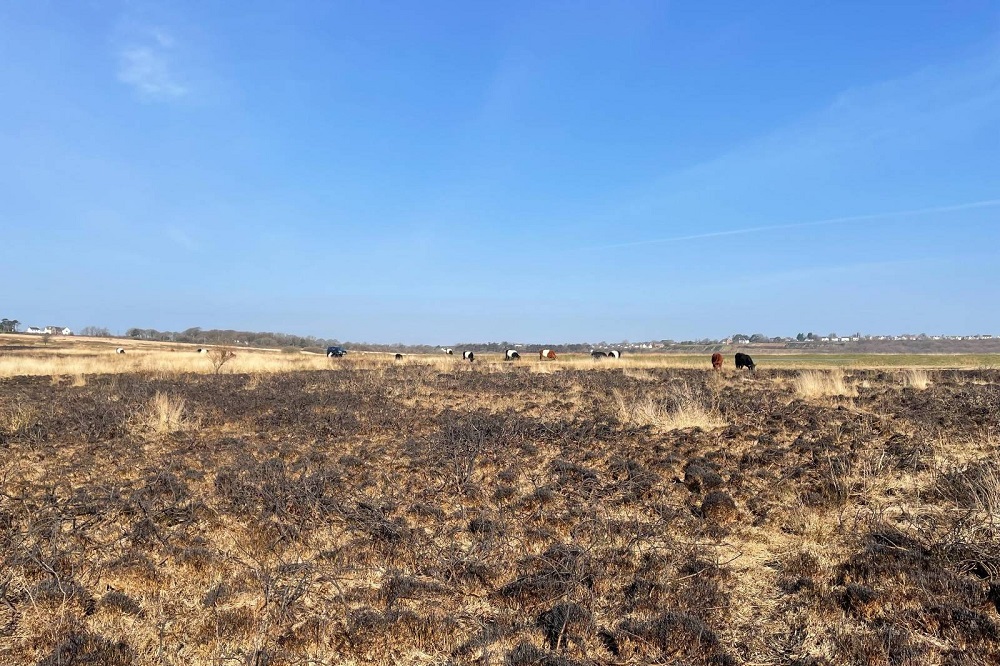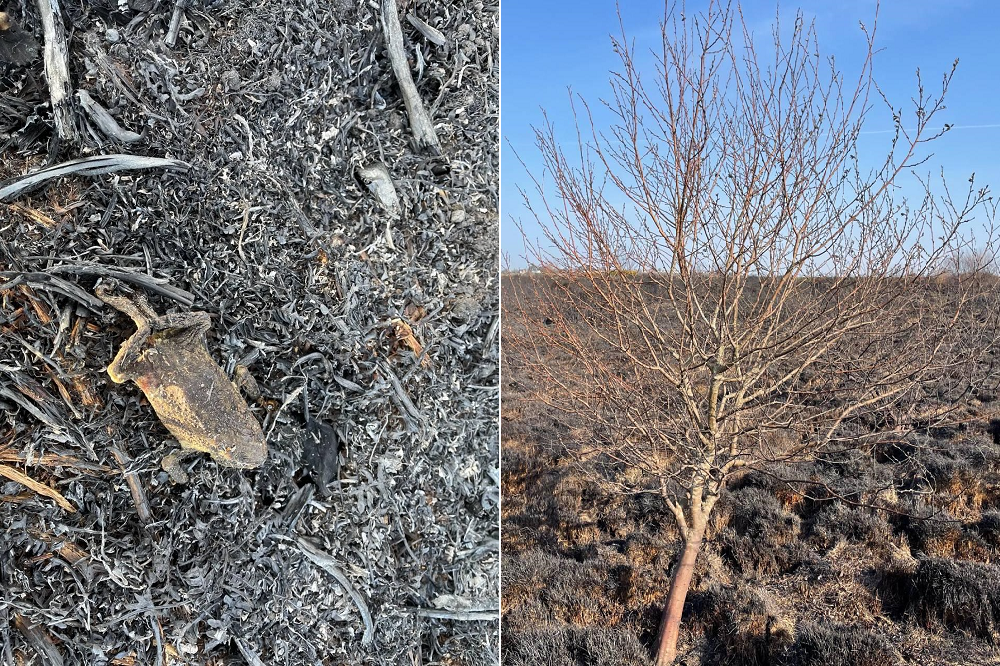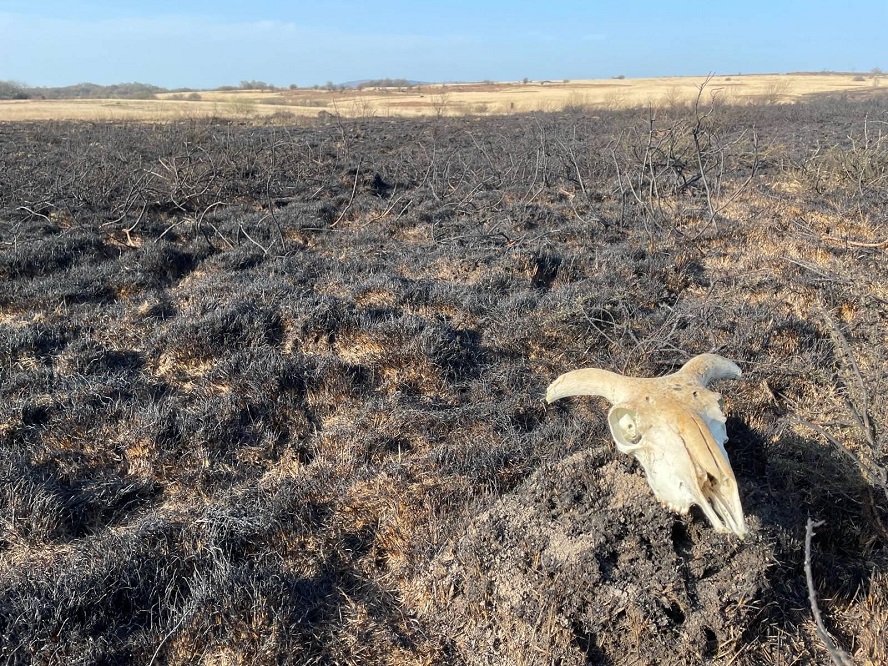Nature: Tawny Clark surveys the torched earth for casualties and survivors

Tawny Clark
Despite the early hour, I feel the sun’s warmth on my skin as I lift my face to a cloudless sky. We’ve had a run of these glorious days. Shorts are on, beer gardens brim with smiles, and thoughts of the approaching summer settle the disquiet of the seemingly endless onslaught of winter.
A herd of free-roaming Belted Galloway cattle graze the road-side verge. I spot the weeniest of calves. It must only be days old, and I feel an overwhelming urge – the magnetic pull of furry cuteness – to rush in for a cwtch. Wisely, I resist. I say, ‘Aww, it’s just sooo cute,’ aloud to myself, and squeeze my hands into fists instead.
Every step I take overloads and confuses my early morning brain. The sound and sensation of the crunching ground beneath my walking boots feels like stepping through the hardened surface of deep snow.
And the smell is one of log fires and toasted marshmallows. Associations which can’t help but boost me, despite the wholly disparate scene. Unlike the frosty snow-angel delights of childhood winters, the ground here is black as soot. Black, because this is soot. A heathland after fire.
Standing at the junction of the A4118 and B4271, northeast of Swansea airport, it’s impossible now for anyone to ignore this often-disregarded landscape. The charred, blackened wasteland is a dramatic and desolate image which will surely burn itself onto the retina of any casual observer.
Today’s survey is different. I’ve come in search of remains. To investigate the toll of such mindless destruction. In the last forty-eight hours alone, vast swathes of Cefn Bryn and Fairwood Common on Gower have burned. Across Swansea, Kilvey Hill set ablaze, and further afield, Abertridwr in Caerphilly, engulfed in flame.
Scorched ground
A traditional management practice with a long history, well-organised and tightly regulated burning of dried grass and woody plants on heathlands can be an effective habitat management technique which helps increase nutrients in the soil and stimulates new growth.
Burning inhibits succession – stopping productive grazing land developing into less suitable scrub and woodland. There are arguments on both sides of this heavily debated and complex topic, however, these current fires are anything but carefully considered or closely controlled.
Spring is a frenetic season for much of our wildlife. Populations live or die by the ability of individuals to mate, raise young and most importantly survive into adulthood.
As an ecologist, you always hope to find something. You’re itching to record and report sightings, whilst eager for the instantaneous rush of endorphins when a greatly anticipated encounter does occur. (It rarely happens).
But this time it’s different. Today I hope, I beg, that I do not find anything.
Each step across the scorched ground heightens the smokiness. When I close my eyes, I picture beachgoers lighting a BBQ on golden sand. But opening them, the feeling here is altogether different.

Dead reptiles are easy to spot.
It takes no time at all before I give up tip toeing cautiously and, with resignation, sacrifice my footwear to the charcoal. A small pond has stayed the raging onslaught of flames, and the blackness at its fringes blends into green. Cocoa butter floats to my nostrils as sun-yellow gorse flowers sigh in respite.
I spot the first casualty of the morning. The charred remains are clearly amphibious, but it’s the closer inspection which identifies the carcass as toad. With shorter legs than their leaping frog cousins, toads walk…slowly. Too slowly.
Against the raging fire, this poor fella didn’t stand a chance. The tragedy hits me harder for the fact that, being only metres from a shallow pond, this individual had been so close to safety.
Life and death
A short distance away, I find myself skirting the fine line between life and death, blackness and lively dancing grassland. A skylark bursts into the air. Its song is loud, insistent. ‘Look at me, look at me’. It’s a distraction technique to draw predators away from its nest.
That the skylark sings with such unflinching determination gives me hope that this is one nest, at least, which has survived. It took to the air only metres from the scorched edge of the burn like a phoenix of the common.
Only ten or so minutes into my purposeful meander, I discover a sheep’s skull – horns and all. A creature long dead. It’s an impressive souvenir, but having neglected to bring a bag, I end up carrying it for the whole two hours I spend on site.
I can only apologise if my seemingly sinister appearance, my obscure habit of criss-crossing a dead zone in slow-motion diagonals, while repeatedly bowing eyes to the ground (reptiles) and to the sky (skylark), while wielding a prophetic sheep’s head, happened to trouble the minds of anyone zooming past me in the relentless column of traffic this morning.

I was half expecting a visit from the local constabulary, but presumably my wholly less menacing attire of fleece, shorts and walking boots could suggest nothing but ecologist.
My outing became rather more intrepid than planned, as I repeatedly blundered distractedly into boggier areas, where crispy tuft-hopping became my only means of escape. But once you’ve accepted that your boots have had it, your legs resemble a Lowri drawing and are scratched to pieces by stray brambles, you just get on with it.
I’m thankful for this spell of warm weather in so much as it makes me hope any reptiles were sun-charged sufficiently to flee the flames, and potentially the reason for the absence of reptile casualties today.
I can’t say the same for the toad, the snails or the golf balls who were not so lucky.
Support our Nation today
For the price of a cup of coffee a month you can help us create an independent, not-for-profit, national news service for the people of Wales, by the people of Wales.





Fairwood common had a small population of hares
?? Are there any there today